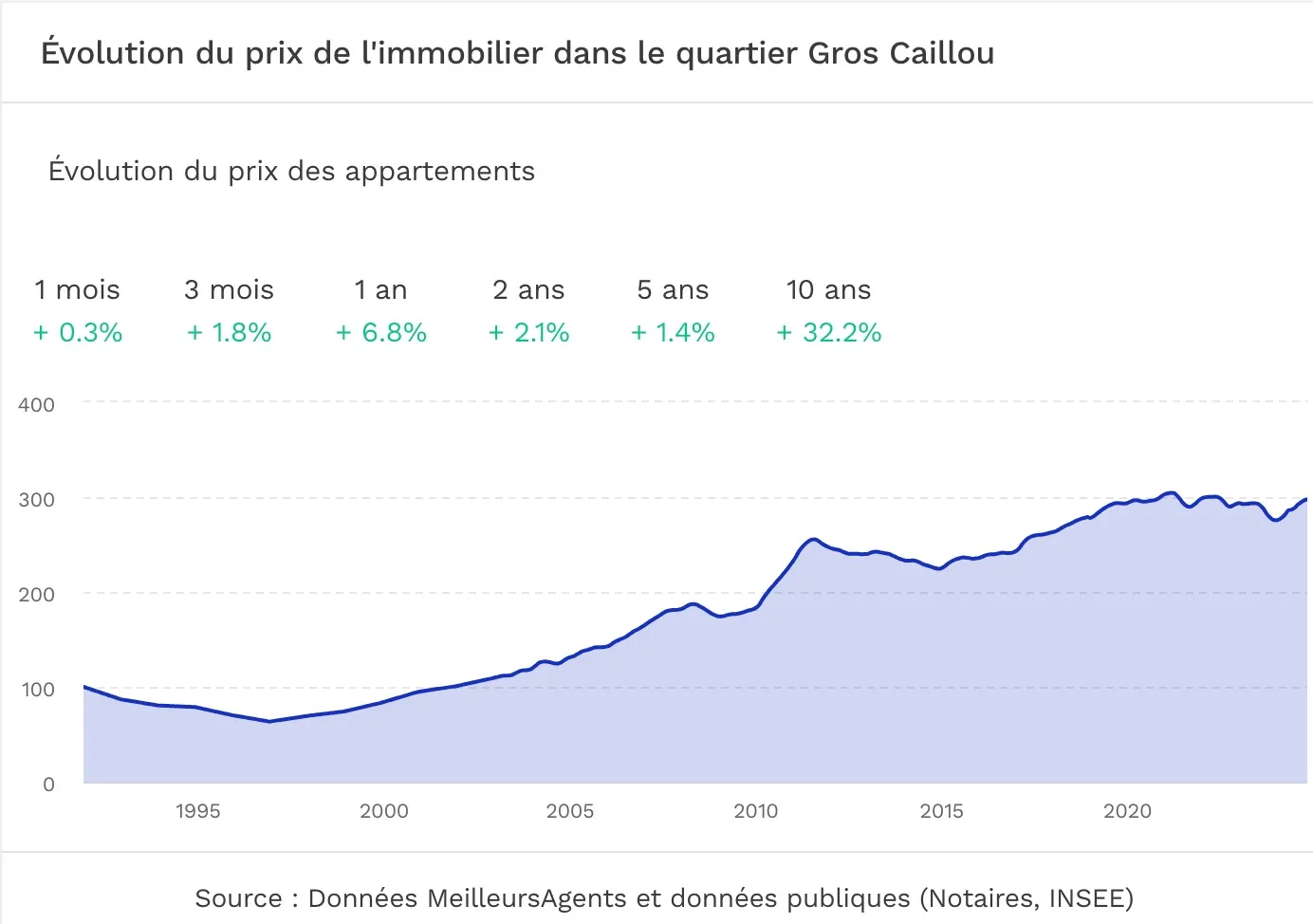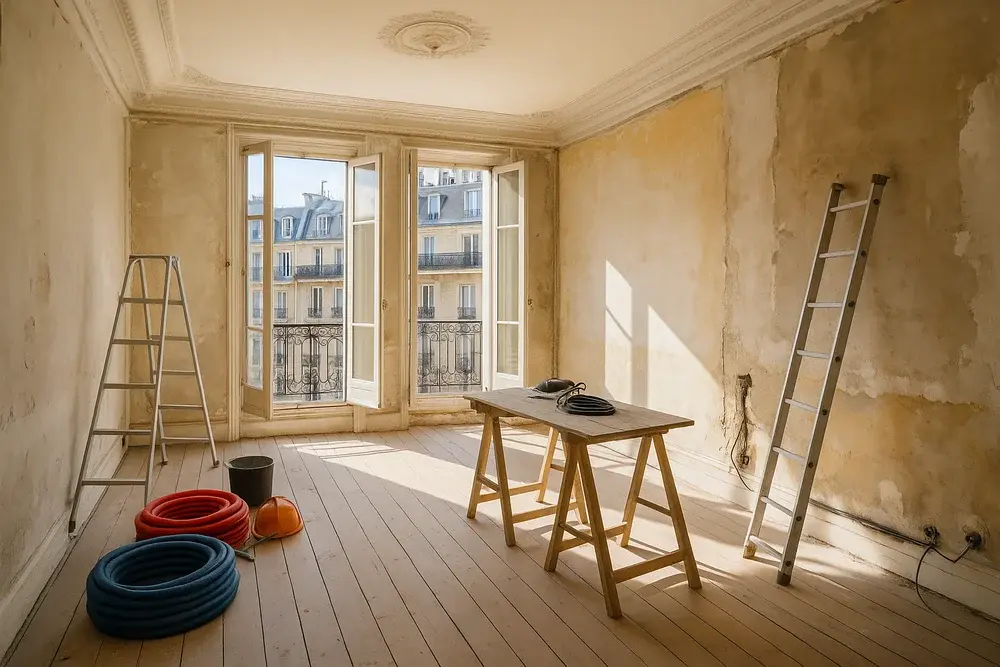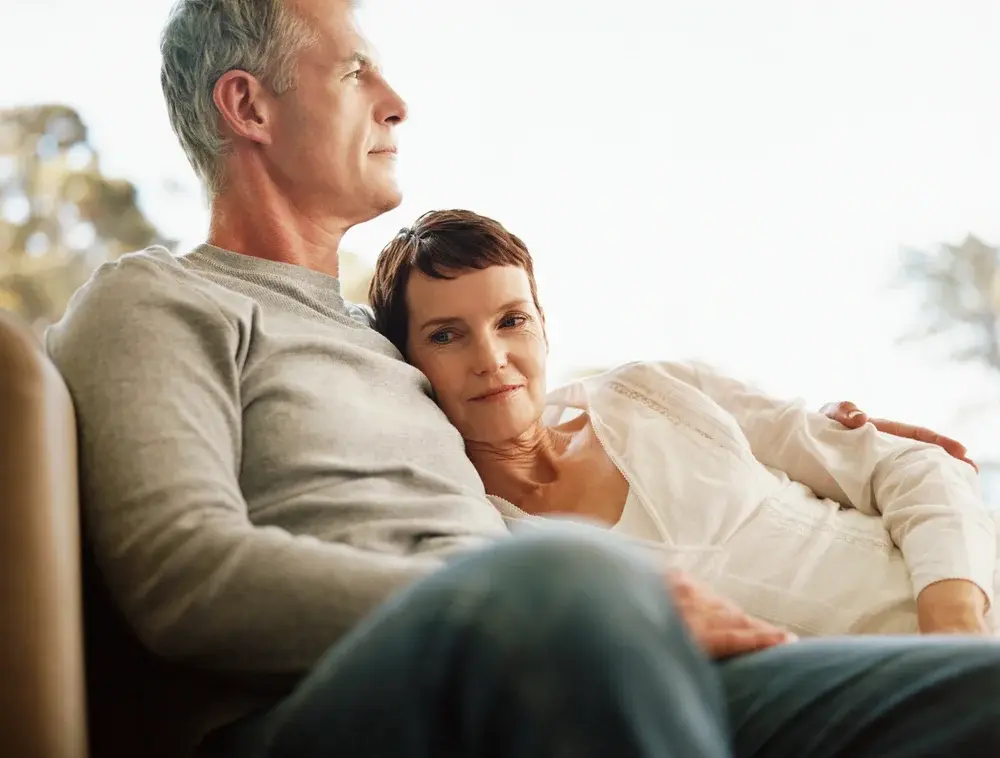The Gros-Caillou district in Paris
Located in the heart of Paris, to the west of the 7th arrondissement, the Gros-Caillou district perfectly embodies the spirit of the capital's western and central districts. It perfectly combines the calm and tranquility of residential neighborhoods with the liveliness and dynamism of its village spirit. It boasts two of the most pleasant shopping streets in Paris: rue Cler and rue Saint Dominique. From an architectural point of view, the district is particularly noteworthy for the superb Haussmann and post-Haussmann buildings that line its main thoroughfares. They also conceal a number of architectural nuggets, some of whose secrets we'll share with you in this article. The Gros-Caillou district is privileged to be home to the Eiffel Tower, Paris' most emblematic monument. The real estate market here is particularly active. Prices are among the highest in Paris. We also offer a detailed analysis of this highly sought-after market.

The Gros-Caillou district: history and origin
The name Gros-Caillou originally evokes a particular geological feature of Paris. In ancient times, the subsoil of Paris was characterized by an abundance of stone. These rock formations, exploited over the centuries, left their mark on street names such as rue du Gros-Caillou. This gave its name to the Gros-Caillou district.
In the Middle Ages, Gros-Caillou was a far cry from today's urban landscape. It was a predominantly agricultural area, with fields stretching as far as the eye could see, dotted with a few farms and hamlets. Quarries were also central to the local economy, providing the expanding town with the materials it needed for its construction.
It was really from the 17th and 18th centuries onwards that the district underwent a profound metamorphosis.With the expansion of Paris's borders, Gros-Caillou, once on the outskirts, was gradually incorporated into the growing urban fabric. Fields gave way to middle-class residences, orderly streets and public squares. The district's evolution has also been marked by ambitious urbanization projects, architectural innovations and the arrival of new populations, bringing with them cultural and socio-economic diversity.
Patrick talks to us about the Gros-Caillou district in the 7th arrondissement of Paris
Architectural richness of the Gros-Caillou district
The Gros-Caillou district boasts typically Parisian architecture, a refined blend of the different styles that have marked Paris throughout its history, particularly in the 18th, 19th and 20th centuries. These were the periods in which the district experienced its greatest growth and transformation.
The Gros-Caillou district abounds in varied examples of architecture, from neo-classical to Art Nouveau to modern. Each period has left its mark, each architect his or her vision, making the Gros-Caillou a veritable open-air museum, a mosaic of styles and eras in harmonious dialogue.
The district's main avenues - Rapp, Bosquet, Bourdonnais and Tour Maubourg - are lined with sumptuous Haussmannian or post-Haussmannian buildings featuring cut stone, balconies on the 2nd and 5th floors with finely chiselled ironwork, and zinc roofs on the 6th floor housing the service rooms. There are also a few special features, such as the Belle Époque building at 33, rue du Champ de Mars, whose glass doors and ironwork were designed by Octave Raquin in 1910. You can see a detail in the photo below:
Photo : detail
Another architectural marvel in the Gros-Caillou district is the building at 29, avenue Rapp, designed by architect Jules Lavirotte between 1900 and 1901 . This building, a veritable catalog of Art Nouveau achievements, with its asymmetrical facade, animal and plant ornamentation, different materials and play of colors that are out of the ordinary in the Parisian architectural landscape, is a must-see when passing through Avenue Rapp.
{{cta-vert-en}}
Gros-Caillou district: lifestyle and gastronomy

Le Gros-Caillou: a Parisian village
The Gros-Caillou is one of the “village districts” that Parisians and happy owners of a pied-à-terre in the City of Light love so much.
The Gros-Caillou district is a pleasant, dynamic, friendly and chic neighborhood.
The heart of this lively atmosphere revolves around the neighborhood's two main shopping streets: rue Cler and rue Saint-Dominique. Here you'll find excellent food shops, bars, coffee shops and terraces packed with people as soon as the sun comes out. You'll also find bookshops and designer boutiques.
Here are a few of our favorite addresses:
Lastre sans apostrophe: the king of pâté en croûte. Rue de Grenelle 188.
Petrossian: for lovers of caviar and smoked salmon. One of the great Parisian addresses of its kind. At 18, av. de la Tour Maubourg.
Arnaud Nicolas : high-end charcuterie at 46 avenue de la Bourdonnais.
Terre de Café: a coffee shop where you can buy or taste exceptional coffees. At 67, avenue de la Bourdonnais.
Tome 7: the Gros-Caillou district's flagship bookshop at 81, rue Saint-Dominique.
Gastronomy in the Gros-Caillou district
If you're looking for a good restaurant, the Gros-Caillou district has it all.
Our canteen for many years: the Café de Mars offers refined, inventive bistronomic cuisine whose high quality has endured for so many years. The restaurant is located at 11 rue Augereau.
La Fontaine de Mars: a must for bistro lovers in the pure Parisian tradition. At 129, rue Saint Dominique.
And for Michelin-starred diners, David Toutain offers bold, inventive cuisine at 29, rue Surcouf; Pertinence at 29, rue de l'Exposition offers contemporary market cuisine; and Tomy & Co at 22, rue Surcouf offers gastro and bistro cuisine of the highest taste.
The Musée du Quai Branly - Jacques Chirac
When it comes to culture in the Gros-Caillou district, the highlight is the Musée du Quai Branly - Jacques Chirac.This is one of the finest museums in Paris. Inaugurated in 2006, the museum is distinguished by its contemporary architecture, designed by Jean Nouvel, and its magnificent landscaped garden, which provides a green setting in the heart of Paris. It's a garden that's a joy to stroll around in when the fine weather arrives in Paris.
The museum is dedicated to the arts and civilizations of Africa, Asia, Oceania and the Americas. Through its temporary and permanent exhibitions, it presents a rich panorama of the diversity and creativity of non-Western cultures. More than just an exhibition space, the Musée du Quai Branly - Jacques Chirac is an invitation to travel and discover. The museum pays tribute to the richness of the world's heritage.
Set against the urban backdrop of the Gros-Caillou district, it offers an enriching change of scenery.
{{cta-bordeaux-en}}
Real estate in the Gros-Caillou district

Resilience of the Gros-Caillou real estate market
The Gros-Caillou district is one of the most sought-after and expensive neighborhoods in Paris. Its real estate market is exceptionally resilient. As proof, it was one of the areas least affected by the real estate crisis that began in 2021. As the price curve below shows, while the Paris market fell by around 15% between 2021 and the end of 2024, prices in the Gros Caillou district held steady.

Property prices in 2025
Average apartment prices will be around €14,500/m2. Beautiful apartments will cost around €17-18,000/m2.Exceptional apartments will sometimes fetch well over €20,000/m2.
Real estate in the Gros-Caillou district
The Gros-Caillou district offers many family apartments in Haussmannian or post-Haussmannian buildings, with generous volumes, herringbone or straight strip parquet floors, marble fireplaces and refined moldings. These apartments are mainly located on the district's main avenues. These buildings generally offer very high-standard common areas.
There are also many buildings built in the early 20th century with more rational apartment layouts. Entrance galleries have been reduced, and long corridors leading to bedrooms and kitchens no longer exist.
Gros-Caillou boasts a number of buildings constructed between the 50s and the end of the 70s. In general, there's no loss of space in these apartments. One of the advantages of these buildings is that the apartments often feature balconies or terraces.
Top addresses in the Gros-Caillou district
The three avenues directly overlooking the Champs-de-Mars: avenue Élisée-Reclus, avenue Émile-Deschanel and avenue Charles-Floquet. Here you'll find apartments with breathtaking views of the Eiffel Tower.
The district's two shopping streets, rue Cler and rue Saint-Dominique, are among the most sought-after addresses for their proximity to shops and friendly atmosphere.
Another coveted address is the Quai d'Orsay, where apartments can offer views over the Seine.
{{cta-vert-en}}
Gros-Caillou: a popular district in central Paris
The Gros-Caillou district is a charming and exceptional place to live. With its sumptuous Haussmann-style buildings, renowned restaurants and friendly atmosphere, it's the perfect embodiment of Paris's elegant village spirit. Its architectural richness, cultural dynamism with emblematic landmarks such as the Musée du Quai Branly, and lively shopping streets make it a unique place to live, sought after by families and lovers of exceptional properties alike.
For lovers of high-end real estate, Gros-Caillou remains a safe bet, where demand often outstrips supply for beautiful apartments and exceptional properties.
Learn more:
- Quartier Gambetta in Paris: an urban exploration
- Quartier Pigalle : a journey through time and culture




